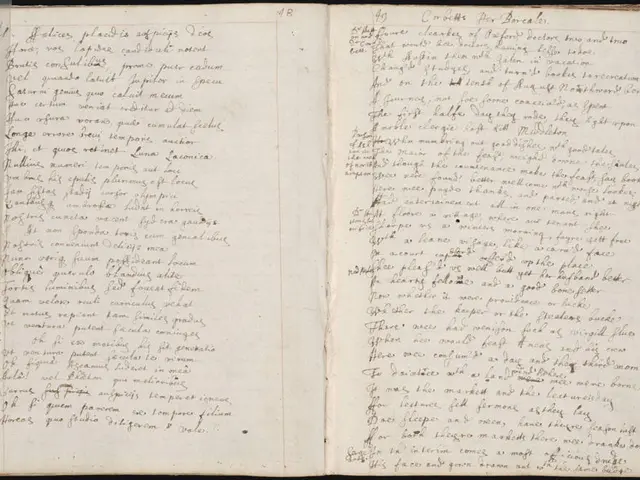Ailing Three-Year-Old Performs Jain Ritual, Depriving Himself of Food, Prompting Medical Professionals to Voice Alarm
Bhopal's Tale: A Tiny Soul's Journey through the Maze of Faith and Law
In the whirlwind of life, where we're all busy chasing our dreams and milestones, a heart-wrenching story unfolds in the city of Bhopal. Three-year-old Viyana Jain, at an age where most kids are lost in the magic of playtime, embarked on a journey that perhaps defied the norms of life and death.
Amidst joyful milestones, Viyana, the only child of IT professionals Piyush and Varsha Jain, was diagnosed with a terminal brain tumor in December 2024. After a tedious battle in Mumbai, including surgeries, her condition worsened by March this year, leaving her family with few hopes. Faced with the prospect of a grim fate, they sought solace in spiritual guidance.
During a visit to spiritual leader Rajesh Muni Maharaj in Indore, little Viyana was subjected to a practice deep-rooted in Jain tradition—'Santhara', a vow of renunciation leading to death, which is sanctified with mantras and rituals.
The girl's mother, Varsha Jain, shared her sentiments, "Gurudev enlightened us, and he explained everything. With our agreement, the 'Santhara' was performed, and 10 minutes later, Viyana left us."
The sudden passing was due to Viyana's already frail condition. Her father, Piyush Jain, added, "We didn't intend to get her 'Santhara', but Guruji suggested it when her condition seemed critical. Everybody in the family concurred."
The incident, which could have slipped under the radar, was recorded in the Golden Book of World Records as the youngest person taking the vow of 'Santhara'.
Whose Decision?
The question that lingers in the air is, could a three-year-old truly comprehend the eternal mystery of death? And, if not, who has the authority to scrap her dreams and life's journey at such a tender age?
"Viyana had a religious understanding equivalent to a 50-year-old," claimed Rajesh Muni Maharaj, who has guided over 100 individuals to take the vow of 'Santhara'.
Legal experts, however, have voiced their concerns.
Supreme Court Advocate Ritesh Agarwal said, "The decision of life and death of a minor is not even at the hands of the parents. This raises a serious legal and constitutional question: Can 'Santhara' be administered to a minor who can neither legally nor emotionally grasp death?"
"Article 25 grants freedom of religion, but not above the law. Even religious practices can't disregard a minor's legal right to life," Agarwal added.
** Legal Dilemma**
'Santhara', or Sallekhana, is an ancient Jain tradition, hailed by followers as a sacred exit – a supreme act of renunciation undertaken when death approaches, and the body can no longer support spiritual pursuits. However, the practice's legality has been debated for generations.
Although the Rajasthan High Court ruled 'Santhara' illegal in August 2015, equating it to suicide under Section 306 of the Indian Penal Code, the order was stayed by the Supreme Court in September the same year following nationwide protests by the Jain community. Yet, critically, these rulings have not addressed the issue of minors taking 'Santhara'.
Indian law also permits passive euthanasia under exceptional and regulated conditions – only with court approval, a clear medical justification, and adult consent.
Blind Spots in the Canal of Justice
Indore Police, however, remain in the dark about the case. Additional Deputy Commissioner of Police Rajesh Dandotiya confirmed, "We have no records of this 'Santhara'. No one reported it to the local police station or administration."
As the debate over this controversial incident continues, experts and activists believe the case underscores the urgent need to clarify the legal status of 'Santhara' for minors in India. As the world astounds at the 'miracle' recorded by the Golden Book, concerns linger about the paradox playing out across the Thames, where faith and law collide, leaving the legal landscape for a minor's right to life murky and uncharted.
- Despite being deeply rooted in Jain tradition, the practice of 'Santhara' for a minor raises questions about the child's comprehension of death and the legal authority to make such decisions.
- Supreme Court Advocate Ritesh Agarwal questions the legality of administering 'Santhara' to a minor, arguing that the minor's legal right to life supersedes religious practices.
- The ruling on the legality of 'Santhara' for minors is still unclear in Indian law, with the Rajasthan High Court's August 2015 ruling on the matter being stayed following nationwide protests by the Jain community, and no records of the incident in Indore Police subsequent to Viyana's case.
- The case of little Viyana Jain has sparked debate over the need for legal clarity on the issue of 'Santhara' for minors in India, with experts believing the case highlights the urgent need for such clarification amidst the blurred lines between faith and law.







